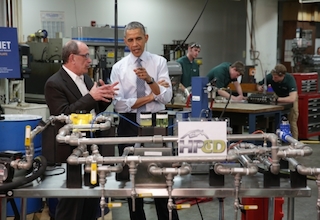During a visit to Cleveland earlier this week, President Obama announced nearly $500 million in new manufacturing initiatives.
The plan is to use the $500 million in a number of ways, including $150 million ($75 million of which would be federal funds, with the other $75 million coming from private investment) for creating a competition for manufacturers, universities and others, the aim of which would be the formation of a manufacturing hub for the development of new fibers and materials for the textile industry.
Another $320 million (again, half of which would be federal funds and the other half private) would go towards strengthening manufacturing in 12 states via the existing network of Manufacturing Extension Partnerships (MEPs).

A more detailed break down of the initiative is at the White House web site here.
But as welcome as this news is, there are those that contend that the real problem for manufacturing lies elsewhere. They point to economic factors that put American manufacturers at a disadvantage.
Scott Paul, president of the Alliance for American Manufacturing, acknowledges that this latest move is “important” but doesn’t go far enough. In fact, he claims that the President isn’t doing the one thing that could truly help manufacturers; support moves to stop currency manipulation by countries like Japan and China.
If this is correct, it would imply that the success of U.S. manufacturing ultimately may not depend much on technological innovation alone. It may be entirely out of the hands of manufacturers and rest solely on fiscal policy and trade agreements negotiated between governments.
However, the debate over currency manipulation is far from over. Critics argue that China is still manipulating its currency and keeping it undervalued in order to keep the cost of its exported goods low. Others counter that while China undervalued its currency in the past, any gains from that practice are long gone. Furthermore, they argue that recent changes in China’s economic policies mean that the currency is no longer undervalued.
What are your experiences with these issues in manufacturing? Leave a comment below to let us know.


Leave a Reply
You must be logged in to post a comment.